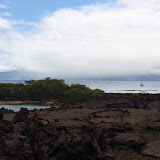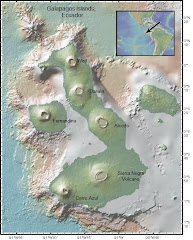 |
| Geologists and Geophysicists |
On the boat crew there were four geoscientists, two geophysicists and two geologists. For this part of the experiment, installing seismic stations, the geophysicists were in charge. As we lugged geophysical equipment over the crunchy pahoehoe at Station GS06, there was some friendly banter about why Daniel, a geologist, persisted in carrying his rock hammer at every stop. The short answer is, “qualitative vs. quantitative.” Qualitative versus quantitative analysis of rocks and the Earth is one way to distinguish a geologist from a geophysicist, but it applies only in the field. Geologists use qualitative scientific skills, observation and documentation, to describe rocks, outcrops, volcanic eruptions, and to choose samples for analysis. They are often able to travel light, wearing a field vest stuffed with compass, GPS, map, hand lens, field book and of course a rock hammer. Their quantitative analysis takes place back in the lab. In contrast, Geophysicists are conducting quantitative analysis from the get go, and they do not travel light. Sensors, computers and power sources accompany them every step of the way. They are catching the waves, light waves, sound waves, water waves or seismic waves. Catching invisible waves requires equipment. Of course this is an oversimplification. But this topic did come up in the field, and circumstances answered the question, “What is the collaborative relationship between a geologist and a geophysicist? “
Seismic Station GS06 proved a challenging installation. It took an hour of reconnaissance just to choose the site, on a ledge next to a relatively deep crevice. It was safe and remote, but repeatedly stepping across the crevice while we worked was disconcerting. We had trouble with the sensor and Falk returned to the ship to exchange for another one. Time passed. Black lava gets hot in the equatorial sun, and lovely, crunchy swirls of pahoehoe are glassy and sharp against your arms and knees. By the time our work was finished, we were hot, tired and wearing small red badges of courage awarded by the sharp lava. We gathered the empty containers, tools and supplies and crossed the crevice for the last time. And the small portable computer, a Clié, fell into the crack. The bonds of friendship and concern for safety kept us calm, but it was a tense moment. We could see it, but no one could reach it safely. Our first attempt at recovery naturally involved duct tape. Daniel attached a big wad to the end of an unused aluminum part of the solar panel mount. No luck. He could touch it, but it was too heavy to stick. Eliana, from halfway into the crack said, “If we had something with an L shape or a right angle, perhaps we could hook the strap.” What she meant was, “We need a geologist with a rock hammer.” It only took a second for me to grab Daniel’s. Duct tape secured it to the aluminum. Eliana hooked the Clié on the second try. We had all learned an important lesson about geosciences and collaboration.
Every geophysicist needs a geologist for a friend and vice versa.
